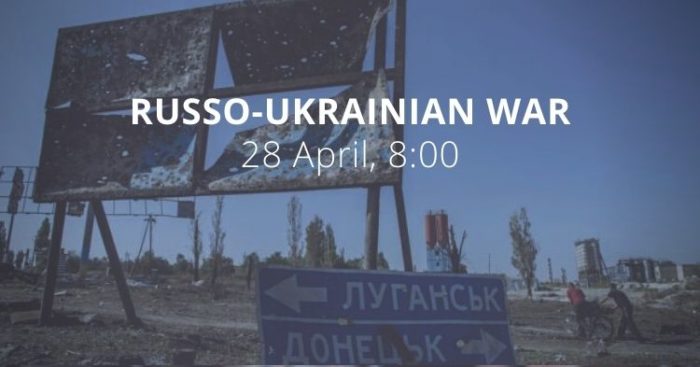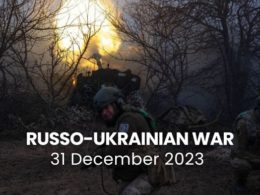3 children among 40 killed in the Dnipro missile strike. Fighting for Soledar continues. Leopards cannot be delivered to Ukraine earlier than 2024 even if Berlin approves delivery tomorrow.
Daily overview — Summary report, January 16, 2023
A map of the approximate situation on the ground in Ukraine as of 00:00 UTC 16/01/23.
There have been no notable changes to control since the last update. pic.twitter.com/MX2m5EoVdE
— War Mapper (@War_Mapper) January 16, 2023
The General Staff’s operational update regarding the Russian invasion as of 18.00 pm, January 16, 2023 is in the dropdown menu below:
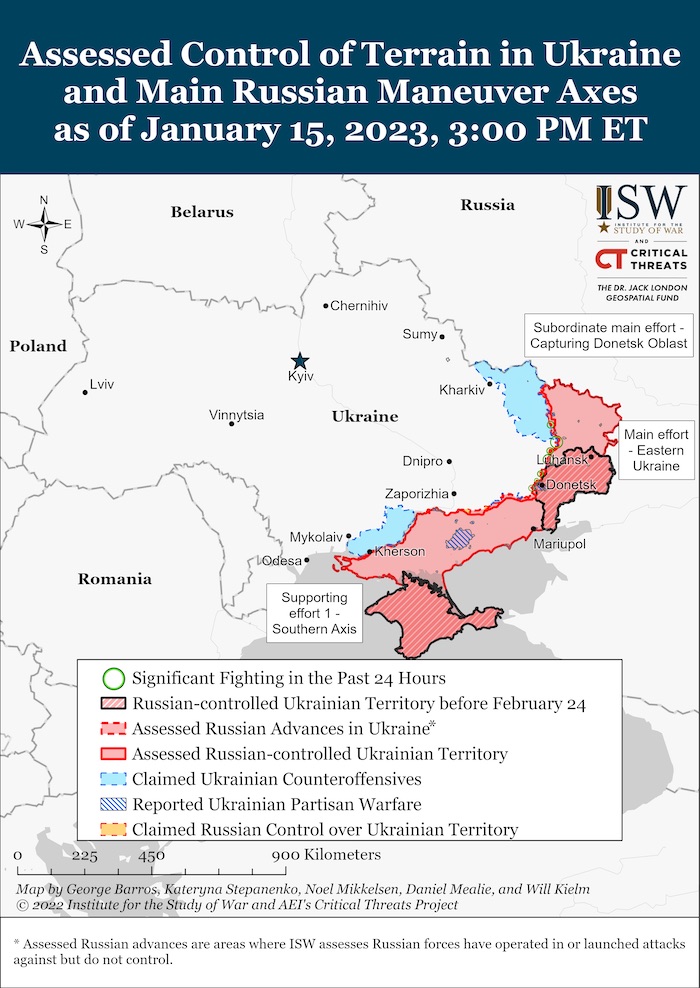
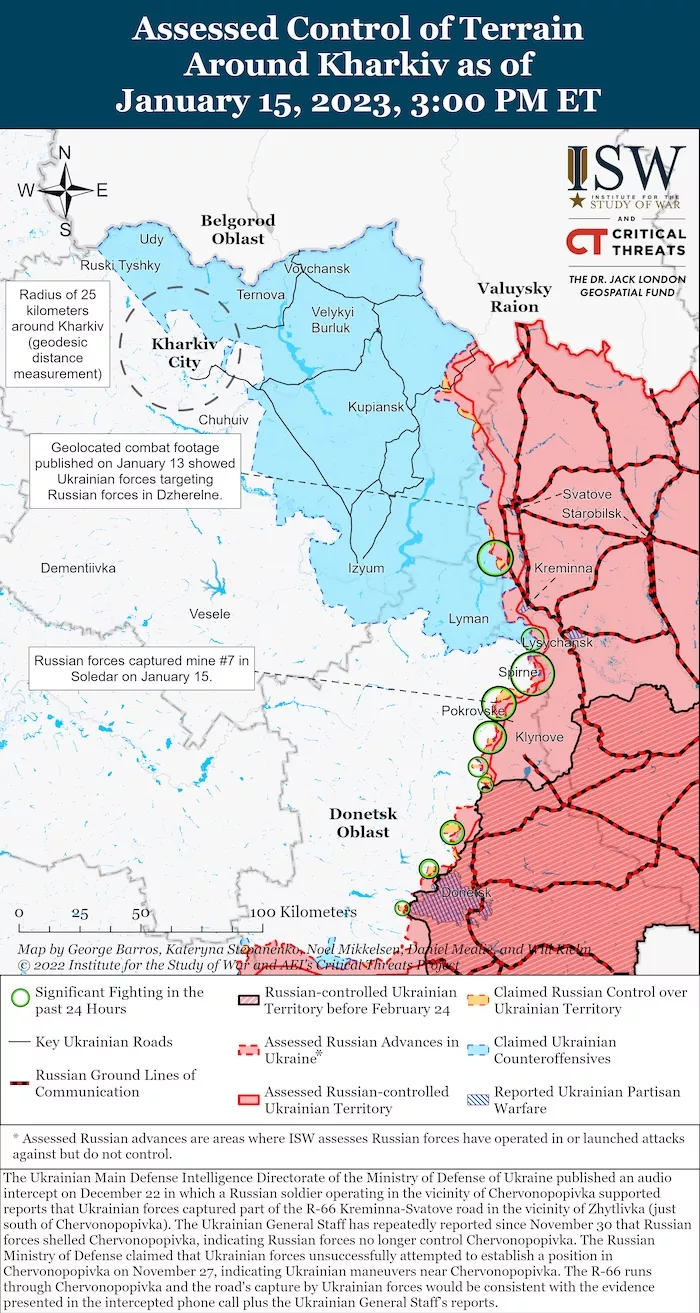
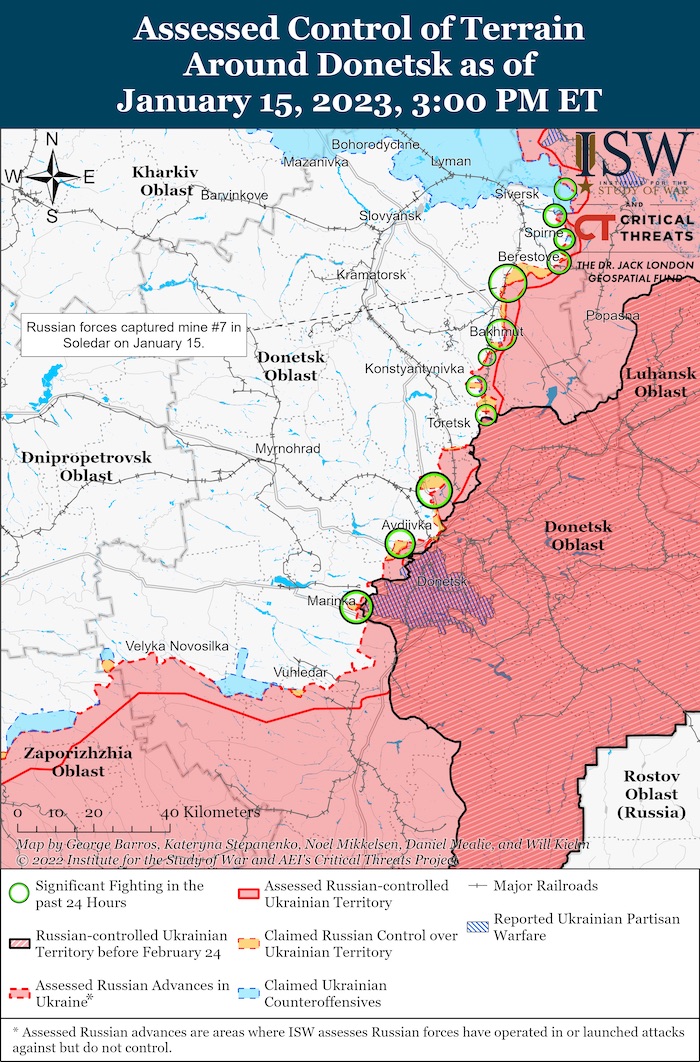
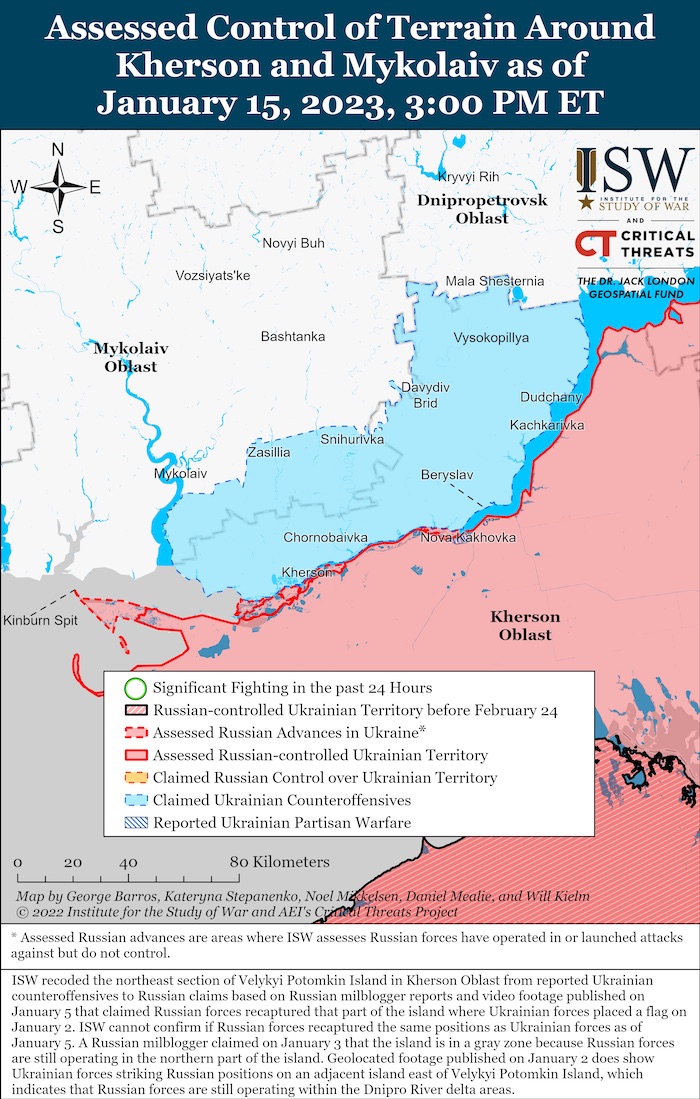
Military Updates

Ukraine “faces difficult choices about how much deeper its military should get drawn into a protracted fight” over Bakhmut as Kyiv “prepares for a new counteroffensive elsewhere on the front that requires conserving weapons, ammo and experienced fighters.” – Washington Post.
Ukraine "faces difficult choices about how much deeper its military should get drawn into a protracted fight" over Bakhmut as Kyiv "prepares for a new counteroffensive elsewhere on the front that requires conserving weapons, ammo and experienced fighters"https://t.co/OoZlhgJhKv
— Euromaidan Press (@EuromaidanPress) January 15, 2023
Rivne Oblast keeps building fortifications to repel possible assaults from Belarus. Head of the Rivne Oblast Military Administration Vitalii Koval says that currently, the busy construction works continue in the region’s northern part bordering on Belarus: engineering and fortification structures such as anti-tank ditches are being actively built there. According to him, all 229 kilometers of the border with Belarus are being fortified to such an extent that Russian troops wouldn’t able to penetrate deep into the region.
Ukrainian medics stoic near front line
"It is very difficult here. But it was no less difficult in other places," surgeon Vadim posted near Soledar says. "Here is where the intensity is greatest. It's definitely hard. But we can handle everything."https://t.co/72oqGf16Zw pic.twitter.com/VKH33CFYca
— Euromaidan Press (@EuromaidanPress) January 15, 2023
Russians demolished Dnipro highrise with Kh-22 missile that Ukraine can’t shoot down. In its 14 January missile attack on Ukraine, Russia demolished an apartment block in Dnipro with Kh-22 missiles, a type that Ukraine’s air defense can’t shoot down. This official statement from Ukraine’s Air Force, signed by Commander of the Air Forces of Ukraine Lieutenant General Mykola Oleshchuk, means that the strike that killed 14 people in the central-Ukrainian city could not be a result of the work of air defense, as President Office advisor Oleksiy Arestovych claimed that evening.
https://twitter.com/EuromaidanPress/status/1614448001262694401
Belarusian army may join Russian invasion of Ukraine in February – Belarusian Journalist. Belarusian troops are highly likely to join the Russian invasion of Ukraine in February 2023, the chief editor of the Belarusian independent news media Charter-97 Natalya Radina said in her interview with UNIAN, referring to the insider information within the Armed Forces of Belarus.
According to British Defence Intelligence, (last 48 hours):
https://twitter.com/DefenceHQ/status/1614941663473852417
- Over the weekend, intense fighting continued in both the Kremina and Bakhmut sectors of the Donbas front. As of 15 January 2023, Ukrainian Armed Forces (UAF) almost certainly maintained positions in Soledar, north of Bakhmut, in the face of continued Wagner Group assaults.
- Around Kremina, fighting has been characterised by a complex series of local attacks and counter-attacks in wooded country. However, overall, the UAF continue to gradually advance their front line east on the edge of Kremina town.
- Over the last six weeks, both Russia and Ukraine have achieved hard-fought but limited gains in different sectors. In these circumstances, a key operational challenge for both sides is to generate formations of uncommitted, capable troops which can exploit the tactical successes to create operational breakthroughs.
Losses of the Russian army
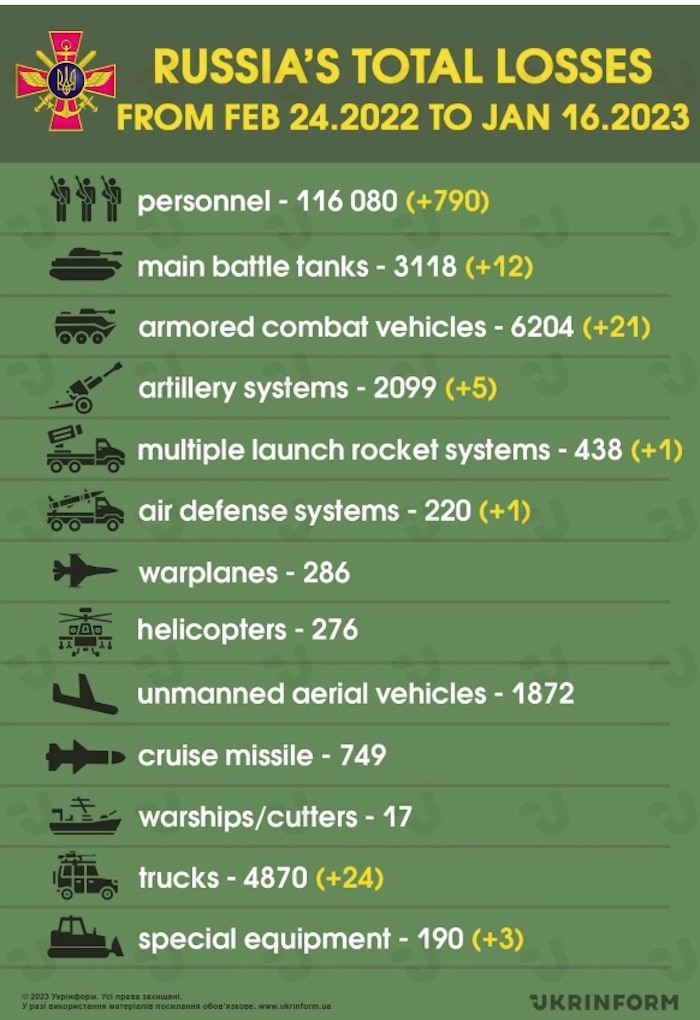
Humanitarian
3 children among 40 killed in Dnipro missile strike. The death toll climbed to 40 on Monday from a weekend missile strike on a high-rise apartment complex in the central Ukrainian city of Dnipro, according to Ukrainian officials.
Head coach of Ukraine’s boxing team of Dnipropetrovsk Oblast killed in the Russian missile strike. On 15 January, the Ukrainian Boxing Federation informed that the honored boxing coach and head coach of the boxing team of Dnipropetrovsk Oblast Mykhailo Korenovskyi was killed in a Russian missile strike in Dnipro city.
Due to Russia’s military aggression, 320 sports facilities were damaged in Ukraine, 87 of them were completely or partially destroyed – Ukrainian Minister of Youth and Sports Vadym Gutzeit.
Russian troops target a rehabilitation center for children, and residential buildings in Kherson. On 15 January, seven Ukrainian civilians in Kherson were hospitalized after the Russian Army targeted the Red Cross office, a rehabilitation center for children, and residential buildings, informed Head of Regional Military Administration Yaroslav Yanushevych.
Russia abducted 2,000 children from Ukraine since New Year – US at OSCE. Russia has abducted as many as 2,000 children from Ukraine into Russia since 1 January and is continuing filtration operations, Michael Carpenter, the US representative to the OSCE has stated.
Environmental
Germany opened its 2nd liquefied natural gas terminal on Jan 14, “part of a drive by Europe’s biggest economy to put reliance on Russian energy sources firmly behind it” – AP.
Germany opened its 2nd liquefied natural gas terminal on Jan 14, "part of a drive by Europe’s biggest economy to put reliance on Russian energy sources firmly behind it" – APhttps://t.co/BRjK2Hu3yI
— Euromaidan Press (@EuromaidanPress) January 15, 2023
Legal
Torture, abductions and deportations fail to crush #Ukraine resistance to #Russia invaders in occupied #Melitopol#Zaporizhzhia #StandWithUkraine #RussiaWarCrimes #StopRussia https://t.co/XvHKE5h4M4 pic.twitter.com/rCZ9uFBgSh
— Halya Coynash (@halyapuff) January 15, 2023
Torture, abductions and deportations fail to crush resistance to Russian invaders in occupied Melitopol. Russia stepped up its methods of terror in occupied Melitopol (Zaporizhzhia oblast) following its forced retreat from Kherson and parts of the Kherson oblast. Ivan Fedorov, Mayor of Melitopol, recently told Dzerkalo Tyzhnia that the Russians who had retreated from Kherson oblast to occupied Zaporizhzhia oblast “are behaving like animals”, abducting and raping civilians. There has also been a sharp increase in looting.
Support
https://twitter.com/EuromaidanPress/status/1614727000362737664
Speaker of Latvian Saeima meets with Zelenskyy during a working visit to Ukraine. On 12 January, Latvian Saeima Speaker Edvards Smiltēns arrived in Kyiv to voice Latvia’s support for the Ukrainian people, who suffer from Russia’s military aggression, and meet with Ukraine’s President Volodymyr Zelenskyy and Speaker of the Verkhovna Rada Ruslan Stefanchuk, the Latvian parliament reported.
Canadian PM Trudeau condemns Russian attack on Dnipro. On 15 January, Canadian Prime Minister Justin Trudeau called Russia’s missile attack on residential buildings in Dnipro despicable and abhorrent. “Russia’s attacks on residential buildings in Dnipro, Ukraine are despicable, abhorrent, and completely unacceptable. Canada condemns this violence unequivocally – we stand with the people of Ukraine, and we’ll continue to make sure they have the support they need,” Trudeau stressed on Twitter.
Germany supplied four mine-clearing tanks to Ukraine. The German government has handed over four mine-clearing tanks, Militarnyi reports. The German Government’s website says that Ukraine has received four mobile and protected mine-clearing systems not specifying the exact type of armored vehicles, but calling the vehicles Minenräumpanzer, “mine clearing tanks.”
UK to supply 14 Challenger 2 tanks to Ukraine in “coming weeks,” followed by around 30 AS90 SPGs. The British Prime Minister, Rishi Sunak, has announced that the UK will send tanks and self-propelled guns (SPGs) to aid the Ukrainian offensive, according to a press release published on the British Government’s website on 14 January. The report says that the PM is “set to accelerate the UK’s diplomatic and military support to Ukraine in the weeks ahead in a bid to push Russia further back and secure a lasting peace.”
New Developments
Rheinmetall can’t deliver Leopards earlier than 2024 to Ukraine even if Berlin approves delivery tomorrow.“Even if the decision is made tomorrow that we can send our Leopard tanks to Kyiv, delivery will take until the beginning of next year,” Rheinmetall CEO Armin Papperger told the “Bild am Sonntag,” according to Der Spiegel.
https://twitter.com/MFA_Ukraine/status/1614669285540106241
Japan PM: East Asia could be next Ukraine
As he urged a united front on a rising China and bellicose North Korea, Japanese Prime Minister Fumio Kishida told Western powers that East Asia could be the next Ukraine.https://t.co/J574taxdzu
— Euromaidan Press (@EuromaidanPress) January 15, 2023
Assessment
- On the war.
The Institute for the Study of War has made the following assessment as of January 15, 2023:
ISW is publishing an abbreviated campaign update today, January 15. This report focuses on Russia’s likely preparation to conduct a decisive strategic action in 2023 intended to end Ukraine’s string of operational successes and regain the initiative.
The Kremlin is belatedly taking personnel mobilization, reorganization, and industrial actions it realistically should have before launching its invasion of Ukraine in February 2022 and is taking steps to conduct the “special military operation” as a major conventional war. Russian President Vladimir Putin began publicly signaling preparations for a protracted war in early December 2022, pledging that Russia will improve upon the mistakes of its earlier military campaigns and setting conditions for a protracted war in Ukraine.[1] Putin notably remarked on December 7 that the “special military operation” in Ukraine could be a “lengthy process” and made several further public appearances throughout December indirectly outlining his goals to improve the Russian war effort’s mobilization processes, revitalize Russia’s defense industrial base, centralize the Kremlin’s grip over the Russian information space, and reinstate the Russian Ministry of Defense’s (MoD) authority.[2]
The Kremlin is likely preparing to conduct a decisive strategic action in the next six months intended to regain the initiative and end Ukraine’s current string of operational successes. Russia has failed to achieve most of its major operational objectives in Ukraine over the past eleven months. Russian forces failed to capture Kyiv, as well as Donetsk and Luhansk oblasts, and to maintain gains in Kharkiv Oblast or hold the strategic city of Kherson. The Russian air and missile campaign targeting Ukrainian critical infrastructure under Army General Sergey Surovikin in late 2022 also failed to generate significant operational effects or demoralize Ukrainian society, as the Kremlin likely intended. Putin and senior Kremlin officials continue reiterating that Russia has not abandoned its maximalist objectives despite Russian defeats on the battlefield.[3] While Putin has not changed his objectives for the war, there is emerging evidence that he is changing fundamental aspects of Russia’s approach to the war by undertaking several new lines of effort.
ISW has observed several Russian lines of effort (LOEs) likely intended to support a decisive action in the next six months.
LOE 1: The Kremlin is intensifying both near- and long-term force-generation efforts. Putin and the Russian Ministry of Defense (MoD) announced plans to drastically expand the conventional Russian military by forming new divisions, reinstating pre-2010 military districts in western Russia, and increasing the conscription age — all indicating Russian intent (though likely not the actual capability) to reform the Russian military to conduct large-scale conventional warfighting.[4] Ukrainian intelligence reported that the Kremlin seeks to raise the number of military personnel to two million by an unspecified date (from about 1.35 million personnel as of September 2022), while Western intelligence officials noted that Russian military command is in “serious preparations” for a potential second wave of mobilization.[5] Some Kremlin officials have begun discussing proposals to expand eligibility protocols for conscription, active mobilization, and the mobilization reserve, while Russian state structures are attempting to resolve past problems by issuing mobilization summonses.[6] Putin himself signed orders that expanded eligibility for mobilization by allowing the mobilization of convicts on November 4.[7]
LOE 2: The Russian military is conserving mobilized personnel for future use — an inflection from the Kremlin’s initial approach of rushing untrained bodies to the front in fall 2022. Putin stated on December 7 that the Russian Armed Forces have not yet committed all mobilized personnel from the first mobilization wave to the frontlines, likely to take time to train and equip these forces for a later, concentrated use.[8] Conventional Russian forces (as opposed to the Wagner Group and the DNR/LNR proxy forces) have not conducted major offensive operations and have mostly maintained defensive positions since the series of successful Ukrainian counteroffensives in the summer and fall of 2022. ISW has monitored conventional Russian units regrouping and training in Belarus and in Russia.[9]
LOE 3: Russia is attempting to reinvigorate its defense industrial base (DIB). The Kremlin began placing a significant emphasis on the resurrection of the Russian DIB in December. Putin has held several senior meetings and visited defense enterprises throughout the country since December.[10] Putin publicly acknowledged issues with supplies, such as the lack of reconnaissance drones, and notably demanded that one of his ministers issue state defense procurement contracts in a shorter-than-planned time frame.[11] Putin and other Kremlin officials have also entertained vague discussions that Russian authorities may nationalize property to support the Russian war effort.[12]
LOE 4: Putin is re-centralizing control of the war effort in Ukraine under the Ministry of Defense and appointed Russia’s senior-most uniformed officer, Chief of the General Staff Valery Gerasimov, as theater commander. The Kremlin is also reinstating the original planners of the war and belatedly attempting to correct command-structure deficiencies. Army General Sergey Surovikin and previous Russian theater commanders failed to achieve the decisive operations Putin — likely unrealistically — intended them to achieve. The Kremlin appointed Gerasimov as the Commander of the Joint Grouping of Forces in Ukraine on January 11 after previously sidelining Gerasimov throughout the full-scale invasion.[13] The Russian MoD also appointed three deputies to closely work with Gerasimov on the expanded scale of tasks pertaining to the “special military operation.” The Kremlin likely intends Gerasimov and his newly appointed deputies to both prepare Russia for a protracted war and take command of a major effort in 2023.
LOE 5: The Kremlin is intensifying its conditioning of the Russian information space to support the war. The Kremlin is shaping the information space to regenerate support for the invasion by reintroducing pre–February 24 narratives and undertaking measures to regain control over war coverage, after previously ceding this space to a variety of independent actors. Kremlin officials resumed promoting a false narrative in late 2022 that the existence of an independent Ukraine threatens Russian sovereignty and culture, justifying Russia’s invasion and ongoing Russian sacrifices as inevitable and necessary “self-defense” measures.[14] Kremlin propagandists have also intensified narratives about the international legal consequences awaiting Russia if it does not win the war, likely to stoke fears of defeat and motivate rededication to the war.[15] The Kremlin has intensified efforts to develop relations with and co-opt prominent pro-war milbloggers who have emerged as a powerful alternative to Putin and the Russian MoD’s deliberately vague war coverage.[16]
The Kremlin’s effort to prepare for a likely intended decisive strategic action in 2023 is not mutually exclusive with the Kremlin’s efforts to set conditions for a protracted war. ISW is not forecasting a “last ditch” Russian effort to win the war in Ukraine. The war will not end, and Russia will not necessarily lose if any of the possible actions discussed below fail. Russia’s rapid attempt to capture Kyiv and conduct a regime change within the first two weeks of the war was a failed strategic decisive action, for example. Many of the aforementioned indicators — such as the Russian MoD’s proposal to create many new Russian divisions — are almost certainly in part intended to support a long-term effort beyond any decisive action planned for calendar year 2023. However, ISW does not assess the Kremlin is simply staying its course as it prepares for a protracted war.
Russia’s decisive strategic action in 2023 can manifest itself in multiple possible courses of action (COAs) that are not mutually exclusive. According to US military doctrine, a military can undertake a decisive action at every level of war to produce a definitive result and achieve an objective.[17] Decisive actions can be at the tactical, operational, or strategic level and can be either offensive or defensive.[18]
COA 1: A major Russian offensive, most likely in the Luhansk Oblast area. Russian forces may seek to conduct a major offensive in the Luhansk Oblast area. The full capture of Donetsk and Luhansk oblasts remain the Kremlin’s official war goals and are among Russia’s most achievable (though still highly challenging) objectives given Donetsk and Luhansk oblasts are logistically the easiest territories for Russia to capture. Russian forces have been deploying additional forces to Luhansk Oblast and undertaking other significant activities since 2022, which ISW assesses can support an offensive operation in Luhansk Oblast.[19] ISW continues to assess that Russian forces are unlikely to conduct an offensive in southern Ukraine in Kherson or Zaporizhzhia oblasts.[20] The Dnipro River separates the frontline in Kherson Oblast and is a serious obstacle to maneuver. Russia’s layered field fortifications array in Kherson Oblast and extensive mining in Zaporizhzhia Oblast indicate Russian forces are prioritizing defensive operations in both provinces.[21]
COA 2: A Russian defensive operation to defeat and exploit a Ukrainian counteroffensive. The Kremlin redeployed significant military units from the southern (Kherson) direction to Luhansk Oblast in late 2022 and established field fortifications in Luhansk Oblast, as well as in Belgorod and Kursk oblasts in Russia.[22] ISW has reported on many observed indicators that Ukrainian forces seek to conduct counteroffensives in 2023.[23] Ukrainian officials have long been publicly signaling their intent to conduct counteroffensives in 2023.[24] Russian milbloggers have also been long warning about Ukrainian counteroffensives.[25] Russia seeks to secure Donetsk and Luhansk oblasts — territories the Russian government has (illegally) claimed as Russian territory — and to avoid another significant defeat like the rout in Kharkiv Oblast or the withdrawal from Kherson City. These were both significant events that degraded Russian morale and the perception of Russian forces’ ability to secure their larger objectives for the full “demilitarization and denazification” of Ukraine. Russian forces may seek to successfully defeat a Ukrainian counteroffensive and deprive Ukraine of the initiative by destroying a significant proportion of mechanized Ukrainian forces. Such a successful Russian decisive action could then enable Russian forces to develop a counteroffensive to exploit disorganized and exhausted Ukrainian forces.
Many of the aforementioned Russian lines of effort could support both COA 1 and COA 2; these scenarios are not mutually exclusive. Russian forces could be preparing for a major offensive operation or, alternatively, larger spoiling attacks short of a general offensive operation. The indicators could also support a counterattack to take advantage of a Ukrainian counteroffensive that Russian forces expect to stop.
The most dangerous course of action (MDCOA) of a Russian offensive against northern Ukraine remains unlikely at this time. However, the Kremlin is creating planning flexibility and will likely expand Russia’s military presence in Belarus in the period leading up to planned major exercises (which could possibly support a combat operation) in September 2023. ISW continues to track Russian and Belarusian activities that could in time support a new Russian attack on Ukraine from Belarus. Russia will likely deploy more forces to Belarus under the rubric of the Zapad (West) 2023 and Union Shield 2023 exercises that will likely occur in September 2023.[26] The Kremlin deployed a senior Russian officer, Commander-in-Chief of the Russian Ground Forces Oleg Salyukov — one of Gerasimov’s three newly appointed deputies — to Belarus on January 12.[27] Salyukov may be intended to create command-and-control structures necessary for a Russian operational strike group. These are anomalous activities that intensify the information operation that Russia will attack Ukraine from Belarus and could support an offensive, though ISW assesses an offensive is still a low-likelihood scenario at this time. There continues to be no evidence that Russian forces in Belarus have created the command-and-control structures necessary for an operational strike group as of this publication.[28]
The Kremlin retains its maximalist goals to seize all of Ukraine, despite its poor conduct of the war to date. The Kremlin has been slow to effectively fix its flawed invasion for almost a year and has repeatedly opted for short-term solutions such as: repeatedly cycling through theater commanders and retaining a fragmented command structure, introducing crypto-mobilization campaigns as opposed to full-scale mobilization, failing to control the Russian information space by allowing different pro-war factions to partition the information space, and consistently disrupting the Russian military’s chain of command. The Kremlin’s apparent new attention to Russian military failures will not allow the Kremlin to fix its conduct of the war in the immediate term if at all, and the flaws in Russia’s original campaign design — and the subsequent losses incurred — will be difficult to replace.
Russian forces remain dangerous, and Ukraine requires sustained support. Ukraine requires further and timely Western support to adequately prepare for the Russian COAs for 2023 outlined above. Ukraine’s Western allies will need to continue supporting Ukraine in the long run even if a Russian decisive action in 2023 fails, as the Kremlin is nonetheless preparing for a protracted war. The West must continue its support to Ukraine’s efforts to defeat Russia’s invasion — and must do so quickly. The Russian military, as the saying goes, retains a vote on the course of the war despite its weaknesses and is actively setting conditions for major operations as the war enters its second year.
Key inflections in ongoing military operations on January 15:
- Ukrainian officials specified that a Russian Kh-22 missile struck a residential building in Dnipro City on January 14, killing at least 25–30 civilians.[29] Ukrainian officials clarified inaccurate reporting that Ukrainian air defenses may have caused the destruction to the building, noting that Ukraine does not have the capability to shoot down Kh-22 missiles.
- Wagner Group financier Yevgeny Prigozhin awarded medals to Wagner Group forces for the capture of Soledar, likely in an ongoing effort to frame the capture of Soledar as a Wagner accomplishment rather than a joint effort with the Russian Armed Forces, as the Russian Ministry of Defense previously claimed.[30]
- The Ukrainian General Staff reported that Ukrainian forces repelled Russian ground assaults near Makiivka and Bilohorivka, Luhansk Oblast.[31] A Russian milblogger claimed that Russian forces are transferring Organization for Security and Cooperation in Europe (OSCE) off-road vehicles from Russia to Luhansk Oblast, possibly for use in combat.[32]
- Russian sources claimed that Russian forces finished clearing Soledar and attacked Ukrainian positions to the north, west, and southwest of the settlement.[33] A Ukrainian source reported that Russian forces captured a mine west of Soledar near Dvorichchia on January 15.[34]
- Russian forces continued to attack Bakhmut and areas to the north, east, south, and southwest of the city.[35] Russian forces made marginal territorial gains southwest of Bakhmut near Andriivka.[36]
- Ukrainian Kherson Oblast Military Advisor Serhiy Khlan stated that Russian forces increased their presence in occupied Kherson Oblast and that some Wagner Group forces arrived in Kherson Oblast.[37] Russian occupation head of Kherson Oblast Vladimir Saldo claimed that the restoration of the Henichesk-Arabat Spit bridge improved Russian logistics into occupied Kherson Oblast.[38]
- A Russian servicemember reportedly detonated a grenade in a building where Russian soldiers quartered in Belgorod Oblast, Russia, possibly in a fratricidal act of resistance against mobilization.[39] A Russian source reported that the grenade attack killed three and injured 10 mobilized personnel.[40]





